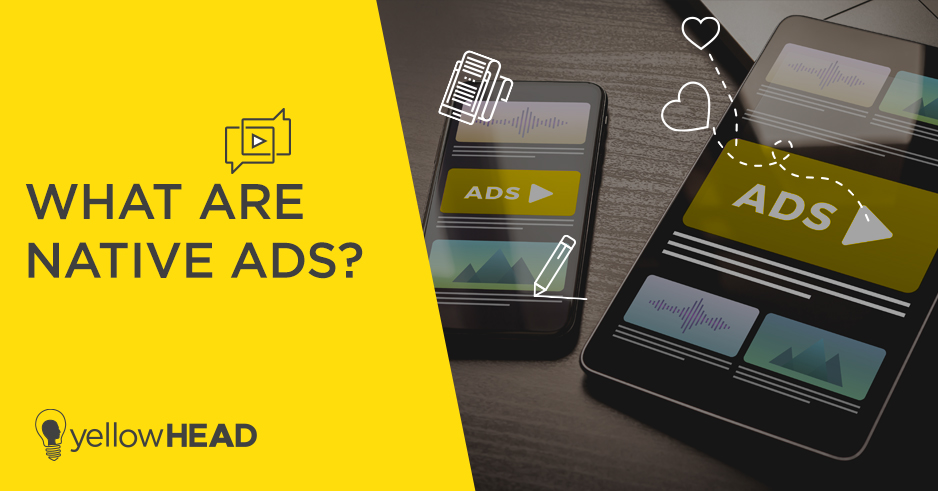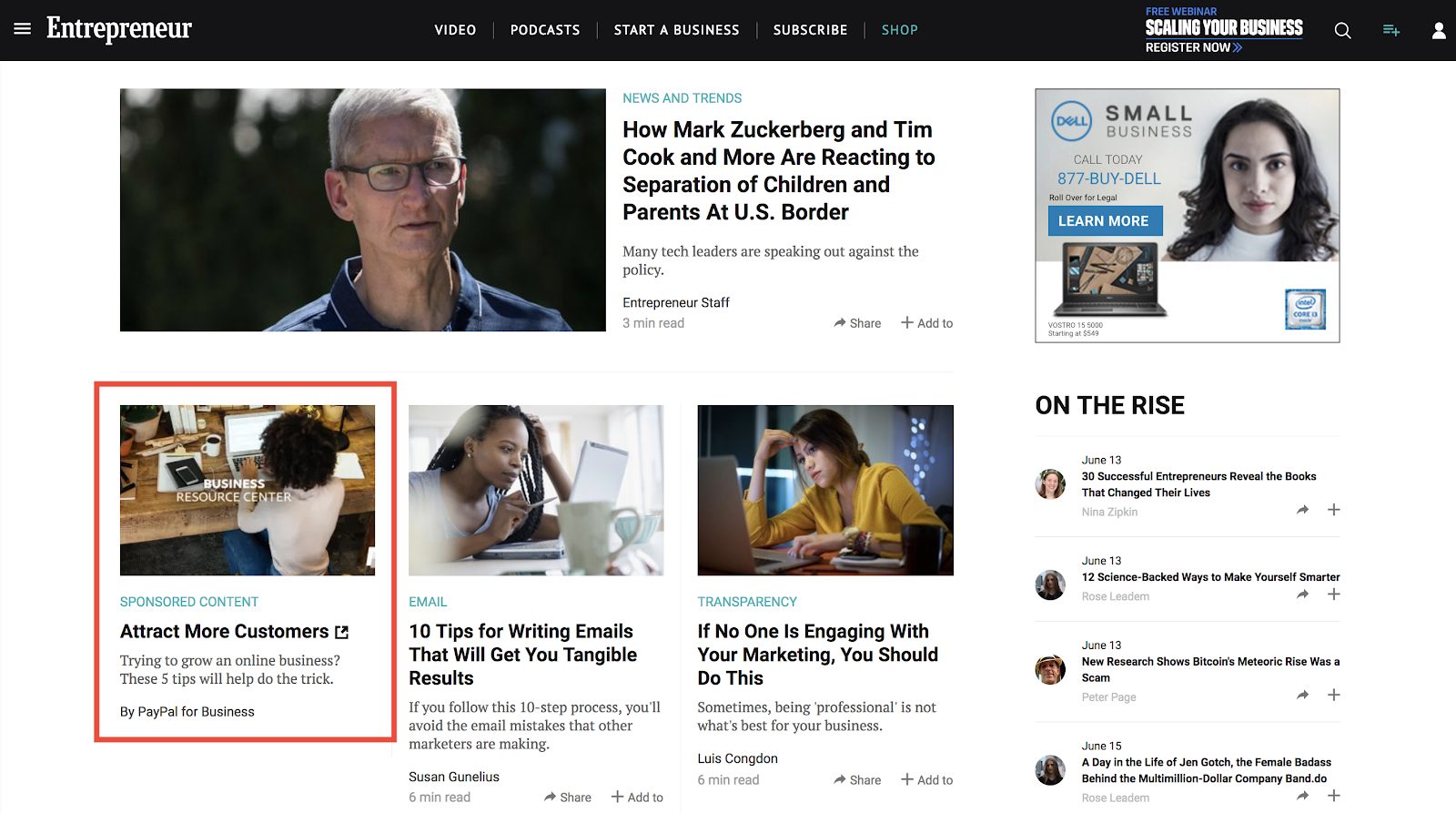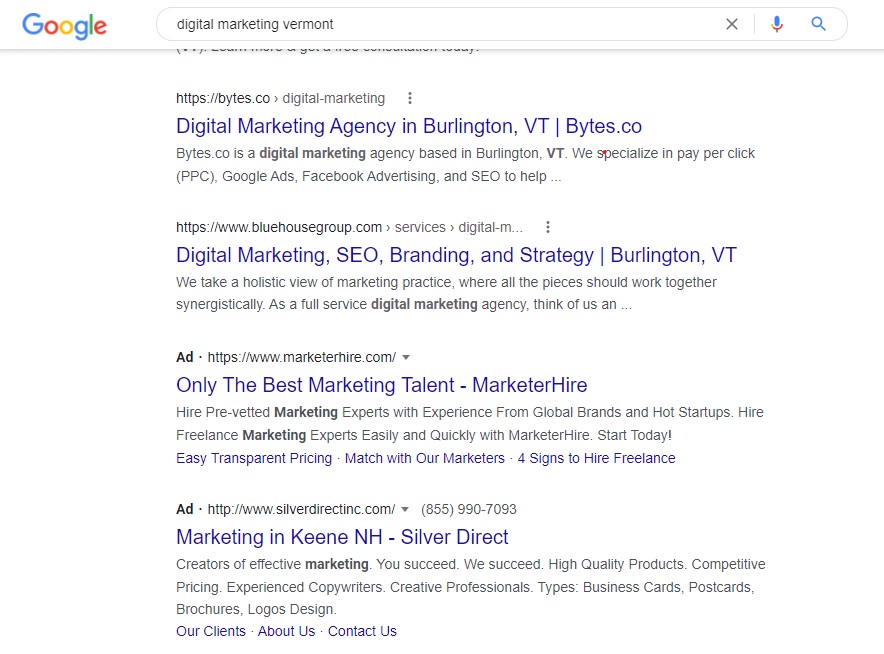Native Advertising: What are Native Ads?
Native ads are essential to any digital marketer’s success. But what are they? And how can you implement them effectively? Read on to find out more.
As an industry, marketing has always moved fast – The bleeding edge is everything in the battle for customers. The rapid speed of development has only gotten faster as more marketing efforts move into the digital sphere.
One area that has taken leaps and bounds in recent years is Native Advertising. When executed correctly, data shows that native ads can be some of the most powerful tools that the modern marketer can leverage. However, deceptive, ill-conceived or badly timed native ads can do untold damage.
Table of Contents
- What Are Native Ads?
- Why is Native Advertising an Effective Digital Advertising Technique?
- The Medium is the Message – How Native Ads Work
- Native Ads and Ad Fatigue
- Native Ads are Seamless (When Done Right)
- Types of Native Advertising – The Big Six
- How Much Do Native Ads Cost?
- What Are the Disadvantages of Native Ads?
- Ownership vs Renting Digital Real Estate
- Is Native Advertising Ethical?
- Native Ads: The Final Verdict
What Are Native Ads?
Native advertising is sponsored content that blends in seamlessly with the content it shares a platform with, with the exception of a “sponsored content” icon or tag.
In other words, a piece of paid content can only be considered native advertising if it could pass for a piece of genuine journalism by readers of the publication it is in.
For a piece of content to be “native”, it needs to match the form and function of the other media that the user is likely to experience. The form can be defined as the structural, visual, and tonal elements of a piece of content, and the function is what a user consumes the content for, e.g. to become educated on a particular subject.
Why is Native Advertising an Effective Digital Advertising Technique?
There can be little arguing that native advertising is effective. Research by Sharethrough and IPG Media labs indicates that:
- “Consumers look at native ads 53% more frequently than display ads
- 25% more consumers were measured to look at in-feed native ad placements (the most common editorial native ad format) than display ad units.
- Native ads registered an 18% higher lift in purchase intent and 9% lift for brand affinity responses than banner ads
- 32% of respondents said the native ad is “an ad I would share with a friend or family member” versus just 19% for display ads.”
Native advertising now accounts for over two-thirds of all digital ad spend of marketing spend, and it’s easy to see why. But why is native advertising so effective?
The Medium is the Message – How Native Ads Work
Native ads are designed to be as unobtrusive as possible. Ideally, they are consumed as if they were any other piece of content, with barely a blip in the consumer experience.
To achieve that “invisible yet visible” quality requires two things – First, that the advert is unobtrusive, that it “fits in” with the rest of the user experience, and second, that it provides value. Specifically, the same kind of value that the user normally gets from the ecosystem where the native ad is presented.
Native Ads and Ad Fatigue
“Ad fatigue” is what happens when consumers get fed up with viewing sales pitches. Eventually, the audience just gives up paying any attention at all. Native ads, insofar as they still entertain, inform, or otherwise provide value, don’t fatigue the audience in the same way as traditional display ads.
Native Ads are Seamless (When Done Right)
A major difference, and arguably the defining feature of successful native ads, is that they do not require a drastic change to the immediate customer experience. You do not need to navigate away or re-orient yourself at all from the content ecosystem you are already in to consume a native ad.
The AOP (Association for Online Publishing) released a groundbreaking study that showed just how powerful native advertising can be. It found that, compared to traditional advertising, native advertising was found to be
- more informative (32% compared to 16%),
- more interesting (27% versus 19%),
- more useful (21% versus 13%)
- and more helpful (15% compared to 10%).
Other key insights from the research show that native adverts garner greater levels of trust among consumers with a third (33%) more likely to trust native advertising than traditional advertising.
Types of Native Advertising – The Big Six
The IAB (Interactive Advertising Bureau) has identified 6 major types of native ads. Success in native advertising depends not only on execution but also on picking the right form of native ad that matches your marketing goals and your brand.
1. In-feed Units
Many websites, social media platforms, and news outlets incorporate some variation of a “feed”. A feed is just a scrolling selection of content, whether that’s posts, articles, or something else that a publisher delivers.
An “in-feed” unit of native advertising, as the name suggests, appears directly in line with the rest of the scrollable content.
Here’s a good example of an in-feed unit of native advertising from PayPal on Entrepreneur.com. Notice how well it blends in with the rest of the content, both visually and in terms of its tone.
Visually, in-feed units should differ from regular content as little as possible. This way, the content is integrated and consumed as if it were a natural part of the user experience architecture.
2. Paid Search Units
A prominent, but perhaps less obvious type of native advertising is sponsored search results. Sponsored search results are clearly labeled as such, and are presented in an almost identical manner to the genuine results.
Here’s an example of sponsored search listings from Search engine mega-giant Google. Notice how, despite the prominent “ad” label, the native advertisement sits unobtrusively among the rest of the genuine, organic search results generated by the phrase “digital marketing Vermont”.
3. Recommendation Widgets
Another location you may find native ads is in recommendation widgets.
Many websites these days employ an intelligent content layer that offers personalized suggestions for content to read in the form of a scrolling or scrollable content carousel. It is common to see native ads embedded in these carousels.
4. Promoted Listings
Amazon is arguably the company that uses sponsored listings most effectively. As you can imagine, sponsored amazon listings are designed to look almost identical to the genuine search results, with the exception of a small piece of text or an icon indicating that it is sponsored. Because sponsored listings are directly relevant to customer’s immediate needs, they often get a favorable response.
5. Display Ads with Native Elements
This type of native advertising looks like a regular ad. What makes this type of ad native is its contextual relevance, both to the publisher and adjacent content.
For example, a clothing brand could promote its style tips on a website that publishes articles on clothing and beauty trends.
6. Custom
This final category recognizes the rapid pace of change in the field of digital marketing. Content as diverse as Snapchat filters and custom Spotify playlists can be forms of native ads.
How Much Do Native Ads Cost?
According to research by CrazyEgg, a native advertising campaign can run between $10 and $200,000.
The actual, final cost of a campaign varies wildly and is largely dependent on the perception and popularity of the publication that you wish to host your native ad on.
There are two main approaches to pricing structure for native ads:
Cost-per-impression
CPM (cost per mille, or thousand impressions) is the traditional way to price digital display ads. The usual costs for these runs around $10-$20 per thousand impressions.
With this approach to native ads, content is generic and/or repurposed from the publisher’s old articles.
Custom Sponsored Content
If you want to go the extra mile and get the most out of native advertising, custom content is the way to go. Some publishers offer to produce custom content for your brand for a fee.
Custom content can be in any form. As we established earlier, native ads are defined by their platform-specific nature, but custom content could be anything from eBooks to Snapchat filters, to videos, infographics, or tweets.
Custom-sponsored content is of the same quality as any other content produced by a publication. Some publications, such as The Huffington Post, even have their own partner studios exclusively for producing content for their paid partners.
What Are the Disadvantages of Native Ads?
Nothing is perfect, not even native advertising. Executed efficiently and for the right reasons, a native ad campaign can be an effective digital advertising technique to boost sales and (even more so) brand awareness.
For all its benefits, native advertising does have some drawbacks.
1. Measuring Success
Measuring the ROI, performance, and sustainability of native advertising campaigns is a notoriously difficult undertaking. To date, there are no unified standards of measurement for native ads, so accurately gauging and tracking the right metrics can be a significant challenge.
2. Time Investment
As we have seen, when executed properly, native ads are exceptionally powerful. However, unlike other forms of marketing, crafting the perfect native ad to capture an audience and convert their attention into buying behavior can take a long time. A/B testing your campaigns should be treated as an essential, rather than optional stage of any native ad campaign.
3. Deception
Native ads should look and perform like the other content that the target audience is likely to be consuming concurrently. However, great pains must be taken to ensure that the audience doesn’t believe the ads are anything other than ads. Fundamentally, people don’t like to be lied to. And they like it even less when they discover they have already been duped.
Ownership vs Renting Digital Real Estate
One of the biggest debates for any digital marketer is whether you want to own the domain(s) where your marketing messages are displayed, or if you would prefer to rely on the reach of third party publishers.
Relying On Other Publishers
There exist today many different platforms designed to deliver native ads to the warmest possible prospects. These companies partner with mainstream publishers and integrate an intelligent content layer directly into the media carousel viewed by users. The type and category of adverts that a user will see adapts based on age, geography, viewing habits etc.
Relying on other publishers to deliver your advertisements and other content to potential consumers has some clear advantages, the number one being reach. If you manage to get your content hosted by one of the larger native advertising platforms, you can pretty much guarantee that your marketing message will be seen by a lot of prospects – You don’t have to worry about growing an audience!
The downsides of relying on other publishers are competition and expense. Unless you host your own ads, your content will always have to compete for prospect’s limited attention. This competition can result in a lower percentage of impressions.
The biggest concern, particular for SMEs, is cost. Hosting your content on the larger, more-established platforms eats into marketing budgets very rapidly!
The Benefits of Owning Your Ecosystem
As an alternative to hosting content with third party publishers, many advertisers prefer to set up their own domain. The benefit of approaching content marketing in this fashion is that it puts you firmly in the driver’s seat, with control over every detail, and minimal competition on your prospects’ attention.
As well as a lack of competition, and incredibly granular control with regards to targeting (aka. deciding which visitors to your platform see which marketing messages), another advantage to setting up your own domain is that you get to keep all of the data for future marketing campaigns. However, it is essential that you comply with all data regulations, including GDPR in the EU.
If you decide to go down the self-publishing route, you will need to ensure that there is sufficient traffic to your page through strong search-engine-marketing (SEM) efforts. After all, it doesn’t matter how creative, compelling or powerful your content is if nobody ever sees it!
Is Native Advertising Ethical?
Despite appearances, native advertising isn’t designed to trick your prospects, especially since most platforms require some sort of “sponsored content” text or icon. It is crucial to point out that even though native advertising looks and feels like “genuine”, unsponsored content, the purpose is not to falsely make prospects believe it is such. Researchers at Stanford University have proven that native ads don’t “fool” people at all – But they still work.
The reason that native content outperforms other forms of marketing is far more about the nature of attention than it is about misleading your potential customers. Constantly switching focus back and forth between different tasks or “modes” can rapidly lead to mental fatigue. Native ads work well because the audience’s attention isn’t interrupted – They can move smoothly through the advertisement and on to other content with only a minimal shift in focus and attention.
It should be clear by now that native advertising isn’t effective because of how well it disguises itself. The success of native ads depends upon how well it stands out while not disrupting the user experience.
With such a variety of media forms and formats (Instagram vs Reddit, for example), it can be tempting to think that each media outlet or platform might require its own specific form of native advertising. Fortunately, this is not the case.
Broadly speaking there are six universal types of native advertising, with specific advantages, disadvantages, and strategies of use.
Native Ads: The Final Verdict
Native ads are such effective and powerful digital marketing tools because they combat ad fatigue and do not require any effort on the part of the audience.
To ensure that a native ad campaign is successful, understand that the form, style, tone, and voice should be entirely determined by the form, style, tone, and voice of the other content produced by the publisher.
Great care should be taken to provide value while still being clear that the content is a native advertisement. Always be upfront with the intent and the purpose of any content you create.





